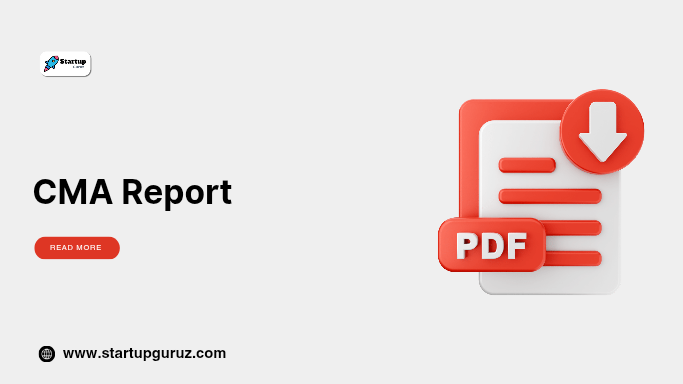CMA Report
CMA Report: A Comprehensive Guide to Credit Monitoring Arrangement (CMA) Report
Introduction
A Credit Monitoring Arrangement (CMA) report is a crucial financial document required by banks and financial institutions when evaluating loan applications for businesses. This report provides a detailed financial analysis, helping lenders assess a company’s financial health, stability, and repayment capacity. A well-prepared CMA report increases the chances of loan approval by offering a structured view of financial performance and projections.
In this article, we will explore the importance, format, preparation process, and benefits of a CMA report, along with a step-by-step guide on how to create one.

What is a CMA Report?
A CMA report is a structured financial document that presents the historical and projected financial performance of a company. Banks and financial institutions use it to assess the feasibility of extending loans or credit facilities. The report generally covers a period of 5-7 years, including past financial data and future projections.
Importance of a CMA Report
- Loan Approval – A well-prepared CMA report improves the chances of securing loans.
- Financial Planning – Helps businesses understand their financial position and make informed decisions.
- Bank Requirements – Most banks mandate a CMA report for large loan approvals.
- Credibility – Enhances the company’s credibility in the eyes of lenders.
- Investment Decisions – Useful for investors to assess business growth potential.
Key Components of a CMA Report
A CMA report consists of several sections, each providing crucial financial details. Below are the primary components:
1. Basic Information
- Name of the company
- Business type and industry
- Loan details and amount requested
- Purpose of the loan
2. Existing Fund-Based & Non-Fund-Based Facilities
- Details of current loans, overdrafts, or credit limits
- Repayment schedules and outstanding amounts
3. Balance Sheet Analysis
- Past and projected balance sheets (5-7 years)
- Assets, liabilities, and equity structure
4. Profit & Loss Statement
- Historical and estimated revenue, expenses, and net profit
- Operating and non-operating income analysis
5. Cash Flow Statement
- Inflow and outflow of cash from operations, investments, and financing activities
6. Ratio Analysis
- Financial ratios such as Debt-to-Equity Ratio, Current Ratio, DSCR (Debt Service Coverage Ratio), and Net Profit Margin
7. Break-Even Analysis
- The point where revenue equals costs, indicating financial sustainability
8. Projected Financials
- Future financial statements based on business plans and growth projections
Step-by-Step Process to Prepare a CMA Report
Step 1: Collect Financial Data
Gather historical financial data, bank statements, loan details, and business plans.
Step 2: Prepare the Balance Sheet
List assets, liabilities, and equity for past, present, and future periods.
Step 3: Create a Profit & Loss Statement
Document revenue, expenses, and net income trends.
Step 4: Cash Flow Projection
Estimate cash inflows and outflows to understand liquidity.
Step 5: Conduct Ratio Analysis
Calculate important financial ratios to determine financial health.
Step 6: Prepare Future Projections
Based on growth plans, estimate revenue and expenses for the next five years.
Step 7: Compile the Report
Ensure accuracy and format it as per banking standards.
Benefits of a Well-Structured CMA Report
- Higher Loan Approval Chances – A clear financial picture reassures lenders.
- Improved Financial Management – Helps businesses track performance.
- Better Decision-Making – Assists in business expansion and strategy planning.
- Enhanced Transparency – Builds trust with financial institutions.
- Early Risk Identification – Detects financial risks in advance.
Common Mistakes to Avoid in CMA Report Preparation
- Inaccurate Financial Data – Ensure correctness and consistency.
- Unrealistic Projections – Make logical and data-backed assumptions.
- Missing Financial Ratios – Include all key performance indicators.
- Lack of Supporting Documents – Provide all necessary records for validation.
FAQs About CMA Reports
1. What is the purpose of a CMA report?
A CMA report helps banks analyze a company’s financial health before granting loans.
2. Is a CMA report mandatory for all loans?
No, but it is required for larger business loans, especially in MSME and corporate sectors.
3. How many years of financial data should be included?
Typically, the report covers 5-7 years, including past and projected financials.
4. Can a CMA report be prepared without a CA?
Yes, but it is advisable to get professional help for accuracy and compliance.
5. What are the key financial ratios in a CMA report?
Common ratios include Debt-to-Equity Ratio, Current Ratio, DSCR, and Net Profit Margin.
6. How does a CMA report improve loan approval chances?
It provides a structured financial overview, making it easier for banks to assess risk and approve loans.
7. What are the common mistakes in CMA reports?
Errors include incorrect financial data, unrealistic projections, and missing supporting documents.
8. How frequently should a CMA report be updated?
At least once a year or whenever seeking new funding.
9. Is there a specific format for CMA reports?
Banks generally follow a structured format, including financial statements, ratios, and projections.
10. Can a small business benefit from a CMA report?
Yes, even small businesses can use a CMA report to understand their financial health and secure funding.
Conclusion
A CMA report is a vital financial document that plays a crucial role in securing business loans. By presenting past performance, current financial health, and future projections, it helps businesses demonstrate their repayment capability to banks. A well-structured CMA report not only enhances loan approval chances but also aids in better financial planning and risk management.
For businesses seeking funding, ensuring an accurate and well-prepared CMA report is a step toward financial success.